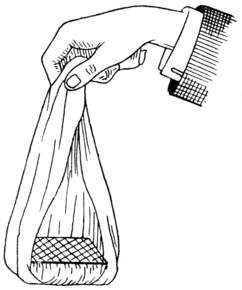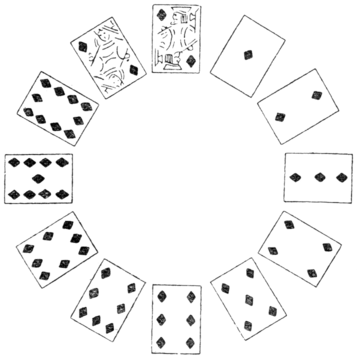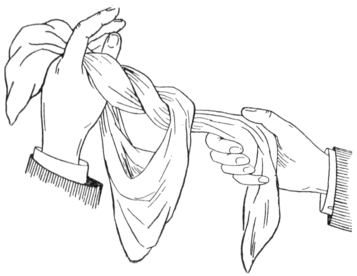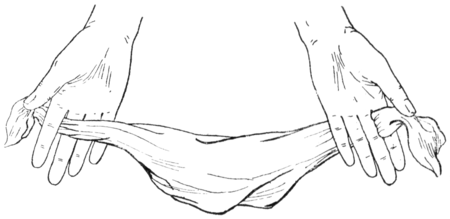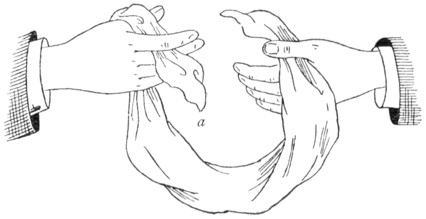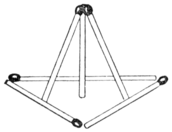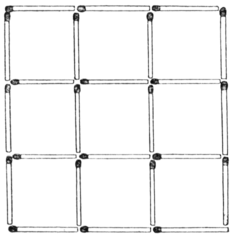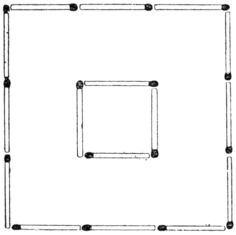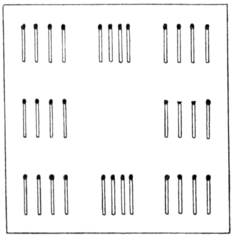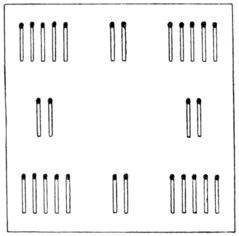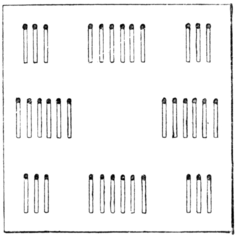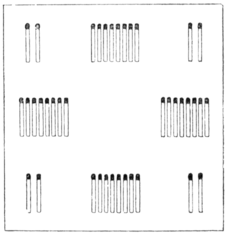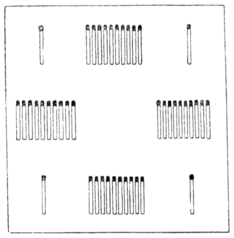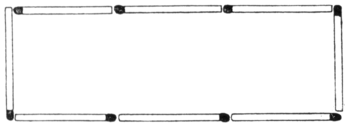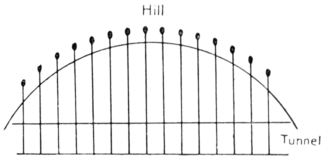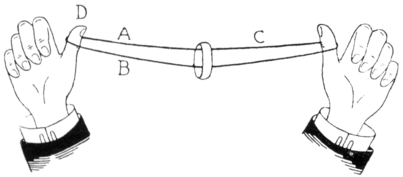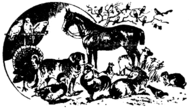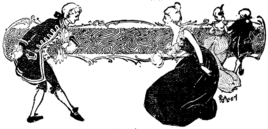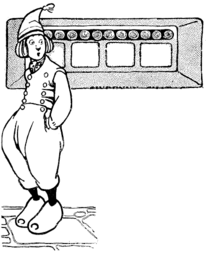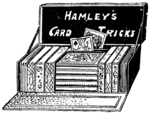TRANSCRIBER’S NOTE
The Contents are placed after the Preface.
The figures have been placed between paragraphs, after they are mentioned in the text. This may result in a figure appearing to be in a different page than it was originally in in the printed book. The same applies to the single footnote of this book.
Two publisher’s advertisement pages were placed at the beginning of the book in the printed book, in this version they have been moved to the end, with the other advertisement pages.
Changes to the original publication have been marked with a dotted underline, and the printed text usually appears in a frame when hovering the cursor on it.
SIMPLE TRICKS
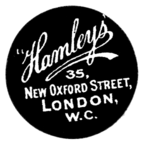
|
PREFACE
The title of this little brochure indicates its contents. Simple Tricks and simple tricks only. No apparatus is required and but little sleight-of-hand is needed in the performance of any of them. They consist of a series of tricks and problems, easily acquired, suitable for gatherings round the table on winter evenings. Some of them are new and many are old; but even the oldest are new to the rising generation. For six of the latest tricks,—“A Hindoo Swindle,” “The Elusive Match,” “A Subtle Impromptu Effect with a Coin,” “A Novel Card Effect,” “An Artful Card Force,” and “Another Easy Card Force,”—I am indebted to my friend Mr. F. Walford Perry, a thoroughly up-to-date and original young conjurer. As I have already said, I have included no tricks which require the exercise of much sleight-of-hand; but even the most simple trick should be thoroughly practised before you present it to your friends, especially those tricks which require the assistance of a confederate. Rehearse everything with him thoroughly beforehand. Even your “patter” should be rehearsed. But endeavour to lead your audience to believe that, like “Mr. Wemmick’s” marriage, it is all impromptu. He said, “Hello! here’s a church. Let’s have a wedding.” You say, “Hand me that serviette ring and I’ll show you 6 a trick.” If, when the contents of this little volume have been thoroughly digested, my readers desire to make a study of more advanced legerdemain, I recommend my Conjuring Up to Date, Card Tricks with and without Apparatus, and Latest Sleights and Illusions to their notice.
For tricks which require apparatus my readers cannot do better than to send to Messrs. Hamley Bros., Ltd., 35, New Oxford Street, or one of their branches, for their Magical Catalogue.
The Daily Telegraph, in a recent article on “Magic Fifty Years Ago,” used these words: “Hamleys’ were then, as they are now, the premier manufacturers of magical apparatus.” A statement which I cordially endorse. The apparatus sold by Messrs. Hamley Bros. is invariably reliable.
In conclusion I beg to offer my readers the following advice:—
Never state the nature of the trick you are about to perform.
Make it a rule never to repeat a trick the same evening unless you have acquired a different way of showing it. In fact, it is advisable to learn several methods of presenting the same trick.
Talk as much as possible and make your “patter” lively, but do not try to be funny unless you are naturally humorous; and, above all, avoid allusions to politics, religion, or any subject about which there may be a diversity of opinion among your audience.
CONTENTS
SIMPLE CARD TRICKS
SIMPLE COIN TRICKS
8SIMPLE TRICKS WITH HANDKERCHIEFS, RINGS, CANDLES, ETC.
| A Knot that Cannot be Drawn Tight | 44 |
| To Tie an Instantaneous Knot in a Handkerchief | 45 |
| Half a Burnt Message Found Restored in a Candle | 46 |
| Two Good Ring Tricks | 47 |
SIMPLE ARITHMETICAL PROBLEMS
MATCH PUZZLES
SIMPLE MISCELLANEOUS TRICKS
9SIMPLE CARD TRICKS
AN EASY METHOD OF FINDING A SELECTED CARD
Throw the pack on the table and request some one to select a card. Then gather up the rest of the cards and request your friend to show his card to his neighbour, to avoid mistakes. While this is being done bend the pack slightly while pretending to shuffle it, and cause the card to be returned and the pack shuffled. The selected card can then be easily detected among the bent cards by its being perfectly straight. A good way to finish the trick is to bring the card to the top of the pack and cause it to project about an inch over the right side; cover the front end of the pack with your four fingers so that the edge of the projecting card is concealed, and, with your thumb at the other end, hold the pack firmly about eighteen inches above the table. Request the person who drew the card to call it by name. On this being done, drop the pack on the table, when the projecting card will be completely turned over by the air in its descent and lie perfectly square on the top of the pack. Another good finish is to bring the chosen card to the bottom of the pack, and requesting the person who selected it to hold the pack by pinching it tightly between his finger and thumb close to the corner, you give 10 the pack a sharp rap, when all the cards will fall excepting the one chosen.
TO BRING A CHOSEN CARD FROM THE BOTTOM OF THE PACK AT ANY NUMBER REQUESTED
Ask a member of the company to take a card, look at it, and return it to the pack. Make the “pass” (Hercat’s Card Tricks, p. 7); “palm” the card (Card Tricks, p. 18) and hand the pack to be shuffled. While this is being done transfer the palmed card to your left hand, and on receiving the pack back, place it over the concealed card, and tell the company you will produce the latter from the bottom of the pack at any number they may name. Supposing some one says, “Let it be the fifteenth card.” You push the pack forward in your left hand, allowing the bottom card to project about an inch toward you, and proceed to draw out the cards above it with your right hand, one at a time, until the fourteenth is reached, when you push the bottom card forward and produce it as the fifteenth.
A CHOSEN CARD SHAKEN THROUGH A HANDKERCHIEF
Request a member of the company to select a card and return it to the pack, which you proceed to wrap up in a large pocket handkerchief, and on the person calling the card by name you shake the handkerchief and the selected card falls on the table.
Explanation.—If you are not an adept at sleight-of-hand 11 it is advisable to use a “forcing pack” which is composed of only three or four cards, of a kind (i.e. ten kings of hearts, ten five of spades, ten eight of diamonds, etc.) with backs to match your ordinary pack. If you can make the “pass” and can “palm” (Hercat’s Card Tricks, pp. 7 and 18) the following is the correct modus operandi. On the card being returned to the pack, carry it to the top by the pass, palm it, and hand the pack back to be shuffled. Place the palmed card face upward on the left hand and cover it with a large white handkerchief, and cause the pack to be placed face down on the handkerchief exactly over the concealed card. With your right hand throw the back hem of the handkerchief over the pack and with that hand grasp the four sides underneath. Then reverse the position of your hands, moving the right hand toward the right on top and taking the left hand away, which will leave the selected card concealed in the fold of the handkerchief (Fig. 1). Ask the person who took the card to name it and request it to leave the pack and pass through the handkerchief. When he does so shake the handkerchief gently and the card will slowly come into view. If you use a “forcing pack” retain a duplicate of the card you intend to force; conceal it in your left hand and proceed as above described.
12A SELECTED CARD FOUND IN A LIGHTED CIGARETTE
Roll a card, say the seven of hearts, in a cigarette paper and stuff a small piece of tobacco in each end. Have this in one of your pockets, where it will not get crushed, ready for palming. Previously arrange with a friend to act as your confederate, and request him when you ask him to select a card to take the duplicate of the one in the cigarette. When ready to present the trick, hand the pack to your friend and ask him to shuffle it, select any card he likes, show it to his neighbour, replace it in the pack, and again shuffle the latter thoroughly. While this is in progress produce some tobacco and a cigarette paper and roll a cigarette, which substitute for the one prepared. If you are not an adept at palming I would suggest the following easy method: Lay your handkerchief across your knees, and on it place the prepared cigarette. While reaching for a match, drop the cigarette you have just made on your lap, as if by accident, and pick up the one containing the card. You can afterwards pick up your handkerchief and put it and the genuine cigarette in your pocket. You then light the prepared cigarette and ask your friend to hand you the pack and name his card; when he does so, tell him you will produce the card in any place he may name.
By previous arrangement he must say, “In the cigarette you are smoking.” You then pick up the pack and “ruffle” it over the cigarette; take the latter from your mouth, extinguish the fire, and tearing the paper in the centre, produce the seven of hearts from it.
13A STICKING CARD
Obtain a short “drawing-pin” with a small head, and having painted the head black, stick it through the centre of the ace of clubs. Put this in your pocket and “force” another ace upon a member of the company. Hand the pack to the person upon whom you have forced the card, request him to replace it and shuffle the pack. Then take the pack from him, and as you turn your back slip the card with the pin through it on the top of the pack. Holding the pack in your right hand with its face toward the palm, ask your friend to name his card. When he does so throw the pack sharply against the door. The top card will be held there by the pin and the rest of the pack will fall on the floor.
This trick was shown by a conjurer before the late King Edward a few years ago, and His Majesty was reported in the daily papers to have expressed “great surprise.”
TWO SELECTED CARDS CAUGHT IN THE AIR
Two cards are selected and returned to the pack, which you then make a pretence of shuffling, taking care not to lose sight of the chosen cards; “slip” (Hercat’s Card Tricks, p. 10) one of the latter to the top of the pack and the others to the bottom face upward. Have a small piece of wax on your right finger and thumb and press the pack between them. Obtain the names of the selected cards, and then throw the pack in the air, moving your hand away quickly, with, of course, the selected cards sticking 14 to your thumb and finger. As the cards descend thrust your hand in among them, and then, separating your thumb and finger, show the cards adhering to them, which you will appear to have caught.
AN EASY BUT PUZZLING TRICK
Any card may be drawn—not “forced”—and returned to the pack. In pretending to shuffle the cards, bring the selected card to the bottom of the pack, and then slip another card in front of it. Show your friend this card at the bottom and ask him if it is his. Of course he will say “No.” Lower the pack, and with the fingers of your left hand draw the bottom card back about half an inch, and with your right hand draw out the next card—which is the one chosen—and place it face down on the table. Shuffle the pack and again show the bottom card, “Is this your card?” “No.” “Then I will place this one on the table”—which you do. Repeat this, and place a third card from the bottom of the pack on the table. Then say, “I am sure your card must be one of the three. No? Look and see for yourself.” He turns the three cards over, and of course finds his card is one of them.
TRAVELLING CARDS
Give the pack to a member of the company, and request him to count off between twenty and forty cards, place the pack on the table, and hand the cards he has counted to you. You then hand the pile to a second person and 15 request him to count off about one-third of the number, lay them in a pile on the table, and hand you the remainder, which you give to the first person, requesting him to place them in his pocket. Taking up the second pile, you request the second person to place it in his pocket. We will suppose the first person selected thirty and the second person abstracted ten cards from them, which should leave twenty now in the pocket of the former. Then announce your intention of causing a certain number of cards to leave the pocket of person number one and travel invisibly into the pocket of person number two. Open a pocket-handkerchief, and covering number one’s pocket, flick it in the direction of person number two, exclaiming, “They have gone!” On the two piles being produced and counted, those from the pocket of number one person will number only fifteen, and the same number will be found in the second pile.
Explanation.—When you receive the thirty cards from the first person, you palm off five or six cards (the number is immaterial) and retain them concealed in your hand, handing the remainder to the second person. When he has counted off ten and placed them on the table, you take those that are left from him and hand them to person number one. When picking up the pile of ten from the table, while pretending to square it, you add the palmed cards and hand the pile thus increased to person number two. You must be careful not to allow the two persons to count the cards after the changes have been made. If you see they are inclined to do so, take the piles from them and place them in their pockets yourself.
16TO NAME ALL THE CARDS IN THE PACK
Ask some one to shuffle the pack, and, on receiving it back, glance at the bottom card. Put the pack behind your back, and then turn the top card round with its face toward you; bring the pack in front of you, the bottom card facing the audience and the turned card facing you. Having already glanced at the bottom card, you can tell them its name, and you now know the card on top. Put the pack behind you again, and move the top card to the front, and turn the one now on top round. Again hold the pack up and name the front card, at the same time noting the card facing you. By repeating this process you can name all the cards in the pack. Take care to have all your audience in front of you, or the turned card will be seen.
A NEW METHOD
Here is an absolutely new method of performing the same trick blindfolded, but with the aid of a confederate. You tell your friends that by placing your hands on a person’s head you can see with his eyes. To illustrate this, tell your assistant to seat himself at a table, and you then stand behind him blindfolded, with your fingers lightly touching his temples. The cards are spread out faces down on the table, and no matter which card he picks up and looks at, you at once say what it is. Of course, you take the tip from him; but how? I will tell you.
He must keep his mouth shut and his teeth together. The slightest pressure between his upper and lower teeth—so slight that it is quite imperceptible—will cause his 17 temples to throb—try it on your own temples—and, of course, by the arrangement of a very simple code he can communicate to you the name of each card. Say one throb stands for hearts, two for diamonds, three for clubs, and four for spades. We will say his temples throb twice. You say, “You are looking at a diamond.” Then we will suppose they next throb five times. You say, “It is the five of diamonds,” and so on. When you come to an ace, of course one throb will suffice; when he picks up a knave, let him give two throbs in rapid succession—a kind of postman’s knock; a queen, a postman’s knock and one throb over; and for a king, a double postman’s knock—rat-tat, rat-tat. With a little practice and a more elaborate code, you can describe all kinds of articles which may be selected—keys, watches, books, etc. It is a capital trick and one which no one can possibly discover.
THE SENSE OF TOUCH
This is an improvement upon the two preceding tricks which I invented several years ago, and have shown scores of times without the modus operandi being once detected.
Effect.—The pack is handed to the audience to be shuffled, and, without even glancing at it, the performer places it behind his back and names each card (presumably by the sense of touch) before he draws it. He can hand the pack back to the audience to be shuffled as many times as desired.
Execution.—Before handing the pack to be shuffled, ascertain which card is on the top, and palm it in the right 18 hand; receive the pack back in the palm of the left hand and cover it with the thumb.
Put both hands behind you and slip the palmed card between the tips of your left first and second fingers; then palm the top card and take the card originally palmed between the right thumb and the forefinger with your thumb on top. While doing this, explain to the audience that you have with considerable practice acquired a marvellously keen sense of touch which enables you to ascertain the name of each card by simply feeling it. You proceed to say: “I will name each card before showing it to you, and you are at liberty to shuffle the pack as many times as you may desire.
“The card I am now feeling appears to be (say) the queen of spades.” You then show the card held between your thumb and finger, at the same time glancing at the palmed card. Throw the former on the table, and putting your hand behind your back again, nip the palmed card with the first two fingers of the left hand, and palm the top card as before. You can go through the whole pack in this manner, but each time you hand it to be shuffled, be sure to have one card palmed. This trick should not be attempted until it has been thoroughly rehearsed.
WHERE IS THE ACE?
Select the ace and five of hearts and two other cards of the same suit and conceal the five behind one of the latter so as to make it appear you have only three cards. Hold the two cards (with the concealed five) faces down, a little distance apart and showing the ace place it deliberately 19 behind them so that the pip shows between (Fig. 2) when the cards are held up. Having shown the cards in the latter position to the company, lower them again and defy any one to lift up the ace. A member of the company does so and naturally looks at the card, when you say, “But you must not look at it. Take the card off and place it face down on the table, and I will then tell you whether your attempt has been successful. We will try again?” Re-arranging the cards, substitute the five for the ace and place it so that the centre pip alone is visible between the two cards. Repeat your challenge and request your friend to remove the ace, place it on the table, and cover it with his hand. When this is done ask him if he still has the ace, and he will naturally say “Yes.” Tell him to raise his hand, and to his astonishment he will find the five.
TO MAKE A PERSON NAME A CARD WHICH YOU HAVE YOURSELF SELECTED
Take any card from two to ten, say the five of hearts, and
lay it face down on the table without permitting any one
20 to see its face. Then announce your intention of examining
a number of the company as to their knowledge about
cards. Ask for a volunteer, and on one consenting to act
tell him to answer your questions rapidly and to make his
replies short. Then put the following questions: “How
many cards are there in a full pack?” Answer, “Fifty-two.”
“How many suits?” “Four.” “What are their colours?”
“Red and Black.” “Now name one of those colours.”
“Red.” If he should say “black,” you must say, “You
select black so I take red. How many suits are there
in red?” “Two.” “What are they?” “Hearts and
Diamonds.” “Name one of those suits quickly.” “Hearts.”
If he should name diamonds say, “Then I take hearts.”
“How many cards in the suit?” “Thirteen.” “How
many between the ace and knave?” “Nine.” “How
many below six and how many above six?” “Four below
and four above.” “Name either below or above?”
“Below.” If he says “above,” say, “That gives me those
below six. What are the numbers below six?” “Two,
three, four, and five.” “Name two of those numbers.”
“Four and five.” If he should say “two and three,” or
“three and four” you remark, “That leaves me four and
five. Name one of those numbers.” If he says “four,”
you say, “Which leaves five.” The suit you selected was
hearts, and now we have come down to five. So you have
actually selected the five of hearts; and I am sure you will
admit I have not influenced your choice in any way.
Please turn over the card on the table.” He does so and, of
course, finds it is the five of hearts.
THE CLOCK
Select twelve cards of any suit, ace to ten and king and queen; arrange them in a circle to represent the figures on the face of a clock, the king as twelve and the queen as eleven (Fig. 3), and request a member of the company to think of one of the numbers. You then explain you will tap the cards with a pencil and he is to mentally add your first tap to the number he thought of and count your succeeding taps until twenty is reached, when he is to call “Stop,” and your pencil will then rest upon his number. For instance, we will suppose he thinks of twelve; he must count your first tap as thirteen and continue counting mentally until twenty is reached.
22Explanation.—Touch the cards at random during the first seven taps and allow your pencil, on its eighth tap, to rest on the king (twelve). Eight and twelve being twenty he will of course say “Stop.” Supposing he thought of a lower figure—seven, for instance. Tap at random as before until your eighth tap, which must always be on twelve; then touch the cards in rotation, making the queen your ninth tap, the ten your tenth tap, nine your eleventh, and so on until you reach seven, which will be your thirteenth tap, which number added to seven, the number thought of, will make twenty, and your friend will say “Stop.”
Another effective trick can be worked with the card dial, but it requires the assistance of a confederate. Having previously instructed him what to do, you tell the company that any one is at liberty to touch one of the cards during your absence from the room, and on returning you will indicate the card he has touched. Upon your returning hand a pencil to your confederate and request him to touch the cards in rotation until you say “Stop,” when the pencil will rest on the right card. Your confederate must hold the pencil in his right hand with his forefinger resting on top. When he touches the right card he must raise that finger slightly. It is a signal no one would notice, and the trick always creates a great deal of wonder.
HOW TO GUESS CARDS THOUGHT OF
Allow the pack to be shuffled freely and then place it on the table face down. Take the three top cards, and holding them up with their backs towards you, ask some one to 23 think of one. Then spread them face down on the table in front of you. Take three more cards, and ask a second person to think of one, and lay these on top of the other three. Show three more cards to a third person, and after he has thought of one, lay these on top of the others. You have now three parcels on the table, each containing three cards. Hold up one parcel, and say to each person: “Is the card you thought of in this lot?” Proceed in the same way with the other parcels, and then tell each person the name of the card he thought of. As the cards shown to the first person were laid on the table first, it stands to reason that the cards he thought of must be at the bottom of the parcel he has said “Yes” to; the second person’s card will be the middle one in the parcel, and the third person’s the top card.
AN INGENIOUS CARD TRICK
Select ten cards, regardless of suit, the ace, and from deuce to ten, arranging them as follows: Lay the ten face down on the palm of your hand, the nine next, and the others in rotation, finishing with the ace, which you call “one.” Give the cards so arranged to a friend, and tell him you will leave the room while he moves cards one at a time, not to exceed nine, from top to bottom, and when you return you will tell him how many he has shifted. You may repeat this feat successfully several times, and finish by requesting him to make up his mind how many cards he intends moving before you leave the room and you will tell him which card will indicate the number he 24 has selected. On returning you immediately refer him to the card which gives the correct answer. This is really a most puzzling trick and yet an easy one to perform. Commence by showing how the cards are to be moved by shifting a few yourself, noting how many you move, so you will remember which card you leave at the bottom. When you return to the room you subtract the number of pips on that card from ten and the product will show the number of the card from the top, the pips on which indicate the number of cards your friend has moved. We will suppose that, in illustrating, you move four cards, which will, of course, leave the four at the bottom; you subtract four from ten, which leaves six, and no matter how many cards have been moved the pips on the sixth from the top will indicate the number. Taking the pack in your hand face downward, count off the first six cards, and glancing at the sixth say, “You moved —— cards.” When you repeat the trick add the number originally at the bottom to the number your friend has moved, which will give the number now at the bottom, which you again subtract from ten. In predicting the number of cards your friend means to move you tell him the number of the card from the top which will show it. We will suppose the bottom card is eight and your friend mentally decides upon moving five cards, you subtract eight from ten, which leaves two, and tell him the number he is going to move will be indicated by the pips on the second card from the top after he has moved the cards.
25TO NAME A CARD WHICH SOME ONE HAS THOUGHT OF
Spread six cards before a member of the company and ask him to think of one. Place these cards at the bottom of the pack and give the latter a “false shuffle,” i.e. shuffle them in such a manner that the bottom cards are not disturbed. Then take the four top cards, and spreading them on the table, faces upward, ask your friend if his card is among them. Of course, he will say “No.” While he is looking at the cards on the table “slip” (Hercat’s Card Tricks, p. 10) one of the bottom cards to the top of the pack. To do this moisten the tips of the two middle fingers of the left hand, and holding the pack in that hand with the moistened fingers against the face of the bottom card, with the thumb and two middle fingers of the right hand raise the rest of the cards slightly and the card adhering to the moistened fingers will be carried to the top of the pack. Again spread the four top cards on the table and repeat the enquiry. If he says “No,” repeat the former process until he says, “Yes, my card is in that lot.” You, of course, know it is the card you “slipped” from the bottom of the pack. You then tell him to gather up all the cards and shuffle them thoroughly; then place the pack on the table, put his hand over it and look you steadily in the eye. You place your hand over his and say, “I can read your thoughts, you took the ——,” naming his card. This is an easy trick to perform and causes great amazement.
26THE REJECTED RECRUITS—A LAUGHABLE TRICK
Select a king and the four knaves and lay the king on the table face upward. Tell the company that the king is recruiting for the army and accepts the knave of clubs, which you place on the king’s right. The knave of spades, which you place on the left, he rejects. The knave of diamonds is accepted and placed on the right. The knave of hearts is declined, and placed on the left.
Now ask your audience how it is that the king, being in want of recruits, accepts two and refuses two.
The answer will puzzle those not acquainted with the trick. It is as follows: Two of the knaves have but one eye each, and are consequently medically unfit.
A NOVEL CARD EFFECT
Effect.—A five-spot card is passed for examination, a two spot of the same suit is then placed face down on the five; after rubbing the cards slightly and separating them a spot is found to have passed from the centre of the five on to the two spot, making a four spot and a three spot. The pack is afterwards shown to be quite an ordinary one without any apparent preparation.
Preparation.—Remove from the pack the five, four, three, and two of any suit. Place the remainder of pack face down on the table. Now place the five spot face up on the back of the pack, the two spot face down on the five, the four face up on the back of the two, and the three spot face down on the four. Then remove the three top 27 cards, without in any way altering their order, and place them on the face of the pack so that the two spot is showing, and turn the five spot face down, so that the pack appears to be without preparation.
Presentation.—Show pack held in left hand and call special attention to the two spot on the bottom of the pack, then lift off the five-spot card and pass it to a spectator with the remark that the centre spot is loose and can be transferred at will to any other card; while the card is being examined you secretly count off the three other prepared cards at the bottom of the pack and keep them separated from the rest with the index finger of left hand. Now take back the five-spot card and place it on the back of the pack, with its face side toward audience. Then with the first two fingers and thumb of right hand take the three other cards from bottom of pack and show them as one card only: namely, the two spot. This movement is best executed by slightly pushing down the three cards with the index finger of left hand until a sufficient amount of projection is obtained for the fingers and thumb of right hand to grip. Now place the apparent two-spot card face toward, and on to the five spot; proceed by gently rubbing the back card with the index finger of right hand, and lift the top card and show it to be a three spot, while the card facing is found to be a four spot, which you also remove. The back of the two-spot card will then be seen and the pack appear to be an unprepared one.
28AN ARTFUL CARD FORCE
Presentation.—First secretly note what the top card of the pack is. Then proceed by asking a spectator to state what card he wishes you to use by giving you a number. After having received the number you proceed to count the cards face down on to a table until you reach that number, at the same time mentioning that the last card counted is the one you are to use. You pause for a moment, apparently thinking, then say, it is possible that the spectator may think that you already know the card as you counted them yourself, you consider that it would only be fair to allow him to count them himself. At the same time you replace the counted cards, and hand the pack to spectator, with the request that he counts down to the number previously stated. This, of course, has the effect of bringing the known top card into position at his number, so that it is quite an easy matter to follow on with any trick in which the sleight-of-hand force is necessary. This seems very simple, but try the effect; even our advanced friends will find it extremely useful.
ANOTHER EASY CARD FORCE
Requisites.—An ordinary pack of cards and two extra cards stuck securely together.
Place the double card below a previously noted card. Hold the pack in the left hand so that the thumb can pass readily down the cards at the upper corner. Now pass the thumb of the right hand down the cards so as to ruffle them. You will find that the thumb is automatically 29 stopped at the double card. By requesting a spectator to take the card immediately above the break in the pack, you can then proceed with any trick in which a forced card is necessary. Numerous other uses for the double card will readily occur to my readers from the hint given.
A SIMPLE BUT PUZZLING CARD TRICK
Place the pack face down on the table and cover it with a serviette. Then request a member of the company to put his hand under the serviette and take a card at random; to be careful not to let you see it but show it to the company and then return it to the pack and to square the pack through the serviette after the card has been replaced. You then lift up the side of the serviette nearest to you and at once produce the card.
Explanation.—When the company are looking at the card slip your hand under the serviette and turn the pack over, and, of course, you can at once detect the “faced” card when it is replaced. On withdrawing it with your right hand turn the pack over with your left and lift off the serviette.
30SIMPLE COIN TRICKS
HOW TO DETECT A MARKED COIN
Place ten coins—say shillings—in any empty finger-bowl
and request a member of the company to select one, put
a private mark on it, and then holding it in his closed hand,
to close his eyes and think of the appearance of the coin
very hard. In about a minute pick up the the bowl, and
going to him, request him to open his eyes; gaze in them,
and then make a few mesmeric passes over his face. Then
request him to drop the coin he holds in the bowl and to
mix it up thoroughly with the other nine shillings. Now
ask some one to blindfold you; when this is done place
your hand in the bowl, and picking up the shillings one at
a time, you can at once detect his, which you throw across
the table to him for confirmation. The secret is that the
coin held in the person’s hand has obtained a certain
degree of warmth and can at once be detected in consequence.
A PENETRATIVE SHILLING
Sew a halfpenny in the corner of your handkerchief and place the latter in your pocket ready for the trick. Borrow a shilling and request the lender to put a private mark on 31 it. Take out your handkerchief and pretend to place the shilling under it, instead of which pick up the corner containing the halfpenny, place it in the centre and grasp it through the handkerchief with your left hand, while you let the marked shilling drop in the palm of your right. Ask a member of the company to hold the shilling (the halfpenny in the centre) in the handkerchief a few inches above the table. Then pick up an empty glass with your right hand, hold it under the table, and request the person who holds the handkerchief to let it fall on the table. The coin in the handkerchief will be heard to strike the latter and at the same time you drop the shilling from the palm of your right hand into the glass and place the latter on the table, while with your left hand you pick up the handkerchief and shake it, being careful not to allow the halfpenny to strike the table again while you are doing so. Request the person who lent the shilling to take it out of the glass and say if it is the one bearing his private mark.
ANOTHER SIMPLE TRICK
Here is another simple trick with a sixpence. Put a small piece of wax on it, and place it, the waxed side uppermost, in the centre of a handkerchief. Then put one of the lower corners of the handkerchief over the coin and ask some one to put his finger on it and press it. Then move the second lower corner of the handkerchief over the other corner, telling your assistant to move his finger while you do so. Next cover the two lower corners with the two upper corners of the handkerchief in the same manner, and ask your assistant if he is sure the sixpence is still 32 there. Of course he will say yes; he can feel it. Then tell him to raise his finger. When he does so, take the two upper corners in your hands, and raise the handkerchief, when the coin will appear to have vanished. Of course, it is sticking to the lower corner of the handkerchief.
A COIN TO DISAPPEAR FROM YOUR CHEEK AND REAPPEAR AT YOUR ELBOW
While sitting at the table turn up your right sleeve, and, taking a half-crown or penny, rub it against your cheek, and then, as if by accident, drop it on the table. Pick up the coin and repeat the process, this time resting your elbow on the table, as you explain, to steady it. Move your hand from your cheek, and the coin has disappeared, and with your left hand produce it from your elbow. Then say, “I will reverse the experiment and send the coin back.” Place your empty hand against your face and your left hand containing the coin under your elbow. After rubbing your face and chin, show the coin again in your right hand and your left hand empty. You require two coins for this trick, one palmed in your left hand. When you rub the coin against your face the second time, drop it inside your collar and produce the palmed coin from your elbow. When you “reverse the experiment,” take the coin from your collar as you are rubbing your face and chin and drop the other coin from your left hand into your handkerchief spread over your knees.
33TWO VANISHED HALF-CROWNS
This trick requires considerable practice, but is a very effective one. Take the two coins in your right hand, and throw them repeatedly, one at a time, into the other hand until the audience begin to think it is a “sell.” Then, offering your left hand (in which the coins are supposed to be) to some one, say: “Well, you try to do it.” Open your hand, and the coins have disappeared.
Explanation.—The last time you throw only one half-crown, and instead of throwing the second, bring the right hand down quickly, and at the same time jerk the coin in your left hand upwards into your right, and it will strike the coin retained there. The clink will be heard, and by closing your left hand quickly you will lead the company to suppose both coins are in that hand. Half-crowns are the best coins for the trick owing to their weight.
A DIVINATION
Request a member of the company (seated) to place a shilling or florin upon each knee, and cover them with his hands with his fingers stretched out. You then tell him, when you turn your back, to raise one of the coins and tap his head with it twelve times just above his ear; then replace it on his knee and cover it with his hands as before; and you will tell him, on examining the coins, which one he raised.
The examination of the coins has really nothing to do with the trick. All you have to do is to look at the person’s hands; the blood leaves the hand that has been raised, and 34 when it is again placed beside the other the difference in colour is most perceptible.
I have performed this trick hundreds of times in drawing-rooms, and it has never been detected, but created great surprise.
AN EFFECTIVE BUT SIMPLE TRICK
Stick a halfpenny (or a shilling) under the edge of a table secretly with a small piece of wax. Show another halfpenny to the company, and when it is returned to you, place it in front of you on the table while you turn up your sleeves. Then place the fingers of your left hand under the table, and with your right hand sweep the halfpenny on the table into your left, at the same time getting hold of the halfpenny under the table, taking care that one coin does not strike the other. Then place your right hand over your left, and pretend to rub the halfpenny the audience have examined very vigorously, and, showing both coins, say you have rubbed one halfpenny into two. You can improve on this trick by using four halfpence on the table and one stuck under the edge. Sweep two coins into your left hand, get possession of the stuck halfpenny, and close your hand. Hold it up, and say: “There are two halfpennies on the table, and I have two in this hand.” Picking up the two halfpennies with your right hand, tell the company that you intend to pass one of them into the other hand. Then lay both hands flat on the table, lift your left hand, and show three halfpennies under it. Slide your right hand off the table, leaving one halfpenny behind, and carrying the second coin away with your fingers. As 35 your hand leaves the table, press the halfpenny with your thumb against your two middle fingers, and nip it with your first and little fingers. Remove your thumb, and you will find you can hold it securely “palmed.” Then with the right hand sweep the three halfpennies back into the left hand, at the same time letting the “palmed” coin fall with them. Close your fingers over them quickly, and picking up the remaining halfpenny from the table with your right hand, say: “I intend to make this halfpenny join its companions. One, two, three—go!”
Pushing it with your thumb against your two middle fingers, palm it as before, and throw the four coins which you hold in your left hand on the table. While the attention of the company is on them, drop the “palmed” coin in your pocket.
CHANGING APPLE AND COINS
Procure two small apples exactly alike, and in the bottom of one scoop out a hole large enough to hold a pile of three sixpences. Make a conical cover out of cartridge paper large enough to cover the apple and about nine inches in height. Obtain six sixpences, three of which place in a pile on an inverted glass goblet. Conceal the other three and the hollow apple in your left hand. Ask some one to examine the cover, and, on receiving it back, transfer it to your left hand and slip it over the apple. Then give the duplicate apple for examination, and, taking the cover by its lower part, and the apple concealed in it, place both over the three sixpences on the glass. Take the apple that has been examined, and put it under the table with your left hand, hold it between your knees, and say: “I command 36 this apple to pass through the table and take the place now occupied by the three sixpences, and the sixpences to fall into my hand.” Bring your left hand from under the table and show the coins, lift up the cover and show the apple on the glass. Then reverse the procedure. Cover the apple on the glass; place the three sixpences under the table; secure the apple held between your knees and roll it on the table; lift up the cover and hollow apple together, and, dropping the latter into your lap, show the former is empty. This trick should be performed sitting.
AN OBEDIENT SIXPENCE
Place two half-crowns (or pennies) on the table and a sixpence between them. Then cover the coins with an inverted wine-glass, the edges of the latter resting upon the larger coins. Challenge any one to remove the sixpence without touching the glass or the money. It is done very easily, and in an amusing manner. You have only to scratch the tablecloth with your finger-nail in the direction you wish the coin to come, saying: “Come hither, sixpence,” and it will at once obey you.
COIN AND GLASS
Cover the mouths of two glasses with newspaper, by gumming it on them, and trim off the edges neatly.[A] Stand them inverted upon two pieces of newspaper in such a manner that the type on the paper over the glasses fairly corresponds with that on the paper on the table. Make two cones of newspaper to fit closely over each glass. Unobserved by the company, place a penny under the glass 37 on your left, which will of course be concealed by the paper on the mouth of the glass. Then borrow a penny, and, placing the cone over the glass on your right, lift the latter covered by the former from the table; lay the borrowed penny on the newspaper, and cover with the glass and cone. You call attention to the fact that there is nothing under the other glass, and you then cover it with the second cone. You now tell the company that at your word of command the penny will leave one glass and travel invisibly over the table to the other glass. You lift the cone from the glass on your right, under which the borrowed penny was placed, and the coin is not to be seen. Then, lifting both the cone and glass together on your left, the concealed penny is brought into view. You now announce your intention of sending the penny back. Place the covered glass over the penny and replace the cover over the glass on your right. “One, two, three—go!” you exclaim and, lifting the cone off the glass on your left, the penny under it appears to have disappeared, and on removing the other glass, still covered by the cone, the borrowed penny will once more be seen. This trick can be worked with one glass only and the penny made to appear to drop through the table in your hand placed under the latter ready to catch it (the penny, of course, being already palmed in your hand); but the use of two glasses makes the trick more effective, and it can be repeated many times without fear of detection. The paper upon which the glasses stand can, of course, be examined; but the glasses when removed from the paper must be covered with the cones, or the paper cover on the mouth of each will be seen.
[A] This piece of apparatus neatly constructed can be obtained at a trifling cost at any of Messrs. Hamley Bros.’ Conjuring Depôts, London.
A SIMPLE EXPERIMENT WITH FOUR SHILLINGS
Borrow four shillings; place one on the palm of each hand, and, holding the palms upward, close your fingers over them. Then request a member of the company to place the other two coins on the nails of your two middle fingers; and announce your intention of throwing a coin from one hand to the other, explaining it is rather a difficult feat to accomplish with your hands closed. Make one or two movements with your hands, and then, as if accidentally, drop the two shillings resting upon your nails upon the table. Apologising for your clumsiness, request some one to replace the coins on your nails, saying you will have another try. Now give your hands a jerk upward; open them and catch the coins on your nails, one in each hand, and tell the company you have accomplished your purpose and sent one coin flying invisibly through the air from one hand to the other. To verify your assertion open your hands and show three coins in one hand and only one in the other.
When you make the first attempt, and appear to fail, in the upward movement of your hands you open them and allow the shilling resting upon the nail of your left hand to slip into the palm, while you permit the coin in the palm of your right hand to fall, with the one above it on the nail, on the table. If this is done neatly the company will suppose it is the two coins from the nails which have fallen. You now have two shillings in your left hand and none 39 in your right. In the second attempt you have only to catch the shillings resting on your nails in the manner described, and on showing one shilling in your right hand and three in your left, your statement that one has travelled invisibly from one hand to the other will appear to be correct.
PUZZLE OF TEN HALFPENCE
Place ten halfpence in a row upon the table, then taking up any one of the series, place it upon another, with this proviso, that you pass over just two halfpence each time. Repeat this until there is not a single halfpenny left. Let the following figures represent the halfpence:—
Place No. 4 upon No. 1; No. 7 upon No. 3; No. 5 upon No. 9; No. 2 upon No. 6; and No. 8 upon No. 10. A little practice will enable the reader to do this puzzle without referring to the figures.
HOW TO INCREASE YOUR WEALTH
Obtain three sixpences exactly alike, place one in your pocket and stick the other two with a small piece of wax under the edge of the table about an inch apart. After showing other tricks produce the sixpence from your pocket and show it to the company to prove it is an ordinary coin. Pull up your sleeves, and if the table has a cover turn it back. Place the coin on the table near the edge over the concealed sixpences, and showing your right hand is perfectly empty place your thumb over the coin and rub it 40 vigorously backwards and forwards on the table. At the same time run your first and second fingers under the table, and securing one of the coins sticking there move it and the coin under your thumb simultaneously off the table, and pinching them together between your thumb and finger, say: “I will show you how to double your capital. I am going to rub this sixpence into two sixpences.” Then showing your other hand is empty use the left thumb and finger to assist in the rubbing, and gradually separate the two coins and exhibit them. Then putting the sixpence with the wax in your pocket place the other one near the edge of the table and repeat the trick, saying: “See, I have now trebled my capital.” Do not allow the company to examine the waxed coins.
A NEAT COIN TRICK
Procure three coins (pennies or half-crowns) exactly alike. Scratch a cross on two, and in the third bore a hole, in which fasten a short piece of black elastic cord. The other end of the elastic tie round your ankle, taking care that the coin does not hang below your trouser leg. Put one of the marked pennies in your left-hand trousers pocket and drop the other one unobserved into the pocket of some one present, or give it to a confederate to hold. Commence by borrowing a similar coin to those you are using and mark it like the others. Hold it between the thumb and finger of the right hand, and, giving it a twist, spin it on the table, then snapping your fingers over it, catch the edge of the coin and it will fly up your sleeve. Close your hand and say, “I will make this coin fly up my 41 sleeve, travel round my back, and pass down my other sleeve.” In the meantime you have secured the penny in your pocket and concealed it in your left hand. Open your right hand, showing it is empty, and then show the penny in the other hand. Lower your right hand, the penny in your sleeve will drop into it, and you can pocket it unobserved. Then ask for the loan of a cap and walking-stick. Request some one to hold the stick, while you hold the cap in your left hand. Pick up the penny with your right hand and pretend to place it on the floor. In doing so substitute the coin attached to the elastic, and, stretching the latter, hold the coin on the floor while you cover it with the cap, and ask the person who has the stick to place its end on the coin through the cap and keep it there until you tell him to move it. Then say, “I command this coin to leave the cap and pass into Mr. So-and-So’s pocket. Move the stick, please, and then lift up the cap.” On the removal of the stick the coin will fly under your trouser leg, and, of course, when the cap is lifted it is no longer on the floor. On the person whose name you mentioned putting his hand in his pocket he will find the coin you placed there, which you return to the person from whom you borrowed the penny.
A SUBTLE IMPROMPTU EFFECT WITH A COIN
Effect.—A coin dropped down the sleeve is slowly rubbed out through the cloth at the elbow.
Requisites.—Two coins exactly alike.
Presentation.—First secretly place one of the coins 42 between the buttons at the end of your left coat sleeve. Then stand with your right side towards spectators with the left arm extended, but slightly bent at the elbow. After having the coin examined, proceed to drop it down the sleeve of the extended arm, when it will fall to the elbow, and ask a spectator to feel that it is really there. Proceed by placing thumb of right hand on the side of sleeve toward spectators, and the fingers at the back, and rub the hand up and down the sleeve from the elbow to the cuff, and at the same time secretly gain possession of the coin between the buttons and bring it down behind the sleeve towards the elbow. Now with a slow pinching movement bring the coin down between the thumb and fingers and apparently out through the cloth of the sleeve, meanwhile moving the left arm up and down slightly. The coin left in the sleeve can be secretly got away by dropping the arm and allowing it to fall into the hand and then pocketed.
AN ORIGINAL COIN SWINDLE
Palm a halfpenny in your right hand and ask a friend (be sure he is your friend) to lend you a shilling. Pick up a glass, invert it, and place the borrowed shilling on its bottom. Then ask your friend whether the coin is on the top or bottom of the tumbler. He will naturally look surprised at such a question; and you then say,—“Ah, I see you know the trick.” Slide the shilling off the glass into your right hand, and as your friend holds out his hand to receive it back, drop the concealed halfpenny into it. The chances are ten to one that he will place the coin in his 43 pocket without glancing at it. Unless you really desire to swindle your friend out of elevenpence halfpenny you will, of course, explain to him how he has been “had.”
A CROSS
Place seven coins on the table, five in a row and one above and one underneath the centre coin. Then challenge any one to form a cross with these coins by moving two only, all the arms of the cross to have the same number of coins. After many attempts and failures show how easy it is to accomplish by taking the two coins at the ends of the row and placing them upon the coin in the centre.
44SIMPLE TRICKS WITH HANDKERCHIEFS, RINGS, CANDLES, ETC.
A KNOT THAT CANNOT BE DRAWN TIGHT
Tie a single over-hand knot in a handkerchief, and holding it in your left hand, give one end to some one, telling him to pull at a given signal. As he is about to do so, slip your left thumb underneath and, letting go the end hanging over your left hand, allow the handkerchief to run between your thumb and forefinger, when it will come out without any knot (Fig. 4).
45TO TIE AN INSTANTANEOUS KNOT IN A HANDKERCHIEF
Hold the handkerchief in both hands; give it a twist; blow on it, and a knot instantly appears in its centre.
Hold the handkerchief as shown in Fig. 5.
Then while in the act of blowing on it bring the hands together quickly, throw the end a, held in the right hand, between the two middle fingers of the left hand and over b; at the same time grasp b between the two middle fingers of the right hand (Fig. 6); pull a under b with the left 46 hand and b under a with your right, and the knot is made. With practice you will be able to do this imperceptibly.
HALF A BURNT MESSAGE FOUND RESTORED IN A CANDLE
Procure two candles and from one cut one-third off, in which piece drill a hole lengthwise and remove the wick. Put this piece in your pocket and place the other candle in a candlestick. Give a small piece of paper to a member of the company and request him to write a short sentence on it. Tear the paper in two, and giving him half, retain the other half yourself, which you fold up. Have a similar piece of paper, folded, concealed in your right hand, and as you turn to get the candle (which should be lighted), substitute one for the other. Burn the plain piece of paper in the candle, and obtaining the piece of candle from your pocket put your hands behind your back, and, having rolled up the half message, work it into the hole in the piece of candle. In order to gain the time to do this stoop over the lighted candle and make several unsuccessful attempts to blow it out. When the paper is in the piece of candle give one good hard blow and extinguish the light. With the piece of candle concealed in your left hand, take the candle out of the candlestick, lay it on the table, and with a knife cut off the burnt end, which throw away and divide the remainder into three equal parts. Then ask the person who wrote the message to select one piece. When he does so pick up the selected piece with your right hand and pretend to transfer it to your left, but retain it in the right and show the piece concealed in your left, which you present to the 47 person who wrote the sentence and request him to pull out the piece of paper, which he will find to be the corresponding half of the piece in his possession.
TWO GOOD RING TRICKS
Take a common ring, about the size of a wedding-ring, and suspend it to the centre of your handkerchief by a piece of cotton four inches long. You can hold the handkerchief up by the corners with the ring hanging in front of you, and the latter will not be noticed. Then let the handkerchief fall over your left hand and the ring in your palm. Request the loan of a wedding-ring, and, having obtained one, put it under the handkerchief, drop it in your palm, and pick up the other ring, which push up in the centre of the handkerchief, requesting some one to hold it there. Next take a drinking-glass in your right hand and request the person to drop the ring in it and the handkerchief over it. Shake the glass, and the ring will be heard to rattle inside. Then stand the glass in the palm of your left hand with its bottom over the borrowed ring, which is concealed there. With your right hand pinch the centre of the handkerchief and lift it up quickly, of course, carrying the suspended ring with it, being very careful not to let the ring strike the glass. The glass is seen to be empty; lift it up and show the ring underneath. Say, “You see, the ring has passed through the bottom of the tumbler.”
A similar and a better trick can be performed with a short cane—say about eighteen inches long—instead of a glass. Commence as in the previous trick, and after you 48 have asked some one to hold the suspended ring through the handkerchief, show the cane, and, holding your left hand back upward, push it through the latter and the borrowed ring, and grasp the cane with, of course, the ring on it, in the centre. With your right hand take the ring and handkerchief from the person who holds them, and request him to take hold of each end of the cane. Now lower the handkerchief until it hides your left hand, when you must move the latter away, leaving the ring on the cane concealed by the handkerchief. Then let the suspended ring fall out of the handkerchief, and if it strikes the cane so much the better. Whip the handkerchief away, and the ring on the cane will be seen. How that ring could have got on the cane while the ends of the latter were being held will puzzle everybody. Pocket the handkerchief with the suspended ring at once, and don’t allow it to be examined.
49SIMPLE ARITHMETICAL PROBLEMS
TO ASCERTAIN A NUMBER THOUGHT OF
Every schoolboy knows the old puzzle: Think of a number; double it; add 10, divide by 2, subtract number thought of; and 5 left. Here is a great improvement upon that problem, which I have seen puzzle some excellent accountants.
Think of a number; multiply by 3; if the result is odd, add 1 and divide by 2; multiply by 3; if result be odd, add 1, and again divide by 2. By how many 9’s is the result divisible?
On receipt of that information you at once give the number thought of. One of the most puzzling features of the trick is that no 9’s are obtainable in the result should either 1, 2, or 3 be thought of, as the following will show:—
| Number thought of | 1 | 2 | 3 |
| multiply by | 3 | 3 | 3 |
| 3 | 9 | ||
| Add | 1 | 1 | |
| Divide by 2 | 4 | 6 | 10 |
| 2 | 3 | 5 | |
| Multiply by | 3 | 3 | 3 |
| 9 | 15 | ||
| Add | 1 | 1 | |
| Divide by 2 | 6 | 10 | 16 |
| 3 | 5 | 8 |
As will be seen, none of these results is divisible by 9, yet the number thought of is correctly given in each instance.
Solution.—When the number thought of is multiplied by 3, you ask the question, “Is the result odd or even?” If the answer is “odd,” make a mental note of one; then proceed. “Add one and divide by two. Is the result odd or even?” If the answer is again “odd,” make a mental note of two; and proceed. “Add one and divide by two. How many nines are obtainable in the result? I do not want to know what the surplus is.”
The above figures illustrate that when 1 is the number thought of there is only an addition of 1. When 2 is the figure, no addition is required to the first result; but the second result being 9, 1 is added and two noted, which, of course, is the figure thought of. When 3 is thought of two additions are necessary, one to the 9 and one to the 15, making a total of three to be remembered, which represents the original number. When 4 or any succeeding number is thought of the final result is always divisible by 9, and in your mental calculation each 9 must represent 4, to which you add the figures you have previously noted.
Number thought of 4 × 3 = 12 ÷ 2 = 6 × 3 = 18 ÷ 2 = 9.
Here we have one 9, which represents 4, the number thought of.
Number thought of 7 × 3 = 21 + 1 = 22 ÷ 2 = 11 × 3 = 33 + 1 = 34 ÷ 2 = 17. From which is obtainable only one 9, which represents 4, to which you add 1 for the first addition 51 of 1, and 2 for the second addition, making a total of 7, the number thought of.
Number thought of,
| 11 | ||
| × | 3 | |
| 33 | ||
| + | 1 | note 1 |
| ÷ 2 | 34 | |
| 17 | ||
| × | 3 | |
| 51 | ||
| + | 1 | note 2 |
| ÷ 2 | 52 | |
| 26 | two 9’s = 8 = 11 |
HOW TO NAME A NUMBER WHICH HAS BEEN ERASED
Request a member of the company to write a row of figures, the number of which is immaterial, add them together and subtract the addition from the row. Then to cross out any figure from the result, add the remaining figures together and give you the total, when you will tell him which figure he has erased. Of course, you do not see his figures and can leave the room while he makes them.
| 567219 | = 30 | |
| - | 30 | |
| 567189 |
We will suppose he crosses out 7, which makes the addition of the row, minus that figure, 29. He gives you that result and you at once name the crossed off figure. There are two ways of arriving at the answer. The simplest and quickest way is to add the units in the result together until only one figure remains and deduct it from 9. For instance, we will take 29. Add the 2 and 9 together, which make 11; add 1 and 1 together and you have 2, which deduct from 9, leaving 7, the figure erased in the above example.
Supposing 1 was the figure erased, the addition of the remaining figures would then be 35; 3 + 5 = 8, 9 - 8 = 1, the figure crossed off.
The second method is to reckon the next multiple of 9 above the figures given you; for instance, supposing they are 29, the next multiple of 9 is 36. Deduct 29 from it and it leaves 7, the erased figure. If either 9 or 0 is erased the result is the same. You can get out of the difficulty, on being told you are wrong, by saying (in case you have given 9), “Yes, I see it is a nought; I thought it had a tail, so mistook it for a nine.” If you have named 0 and it turns out to be 9, you can say, “Oh, I didn’t notice the tail; of course I should have said nine.”
A LESSON IN THE CORRECT FORMATION OF A FIGURE
Request a friend to write the following figures:—
Take the paper from him and, after pretending to scrutinise the row, ask him to point out which figure he considers 53 most imperfectly made. If he should select the 1, say, “You had better practise making that figure. Oblige me by multiplying the row by nine.” When he does so the result will be
Then say, “After this practice you will be able to make better ones in future.”
If he selects the 4 request him to multiply by 36 and the result will be
Whichever figure he selects, mentally multiply it by 9 and request him to multiply the row by the result. If he thinks 9 the most imperfectly made figure, you, of course, tell him to multiply by 81 and the result will be all 9’s.
FOUR NINES PROBLEM
How can four 9’s be written so that they will make 100?
999⁄9
AN ANSWER TO A SUM GIVEN IN ADVANCE
Ask some one to start a sum in addition by writing the top line of four figures. We will suppose he writes 1912. 54 You mentally subtract the 2 and place it before the 1, making 21,910, which figures write on a piece of paper, which you fold up and lay on the table. You then ask a second person to place four figures under the first line. Then add a line yourself, which must be a deduction of the second line from four 9’s. Ask a third person to add four figures to those already written. Then add another line yourself, making it a deduction of the third person’s figures from four 9’s. Request a fourth person to add up the sum and tell him you have already done so, and he will find the answer on the table. The sum will appear something like this:—
| 1912 |
| 7234 |
| 2765 |
| 4891 |
| 5108 |
| 21,910 |
Which answer corresponds with the figures on the paper, which has been on the table the whole time. If you have in the company two friends upon whom you can rely as confederates, previously arrange with them to write the third and fifth lines, explaining to them that they must deduct the line immediately preceding theirs from 9’s and make their lines the products. This adds greatly to the mystery of the trick.
AN ARITHMETICAL PUZZLE
Take 9 from 6; from 9 take 10, and from 40 take 50, and you will find 6 remains.
55| FROM | SIX | FROM | IX | FROM | XL |
| TAKE | IX | TAKE | X | TAKE | L |
| S | I | X |
AN ARITHMETICAL MYSTERY
Thirteen commercial travellers arrived at an inn, and each desired a separate room. The landlady had but 12 vacant rooms, which may be represented thus:—
| 1 | 2 | 3 | 4 | 5 | 6 | 7 | 8 | 9 | 10 | 11 | 12 |
But she promised to accommodate all according to their wishes. So she showed two of the travellers into room No. 1, asking them to remain a few minutes together. Traveller No. 3 she showed into room No. 2, traveller No. 4 she showed into room No. 3, traveller No. 5 into room No. 4, traveller No. 6 into room No. 5, and so on until she had put the twelfth traveller into Room No. 11. She then went back to where she had left the two travellers together, and asking the thirteenth traveller to follow her, led him to No. 12, the remaining room. Thus all were accommodated. Ask your friends to explain the mystery.
HOW TO TELL HER AGE
Girls of a marriageable age do not like to tell how old they are, but you can find out by following the subjoined instructions, the young lady doing the figuring: Tell her to put down the number of the month in which she was 56 born, then to multiply it by 2, then to add 5, then to multiply it by 50, then to add her age, then to subtract 365, then to add 115, then tell her to tell you the amount she has left. The two figures to the right will tell you her age and the remainder the month of her birth. For example, the amount is 822, she is twenty-two years old and was born in the eighth month (August).
A RACE IN ADDITION
Tell a friend that you will race him in counting from 1 to 100, and guarantee to win, under the following conditions: You will allow him to start first, at any number from 1 to 10, and you are both to have the privilege of adding any figure up to 10 to the last number called. For instance, we will suppose he starts with 5. You call 15, having mentally added 10 to his number. He then calls 20, having added 5; and so on, until 100 is reached. Until he sees through the trick you will win every time, and even then you will win if you start first and commence at 1. In that case, as he can only add 10, his first call could not exceed 11, to which you immediately add 1 and call 12. If his next call is 22, you say 23. No matter what his additions may be, the numbers you must always reach first are 12, 23, 34, 45, 56, 67, 78, and 89. When you call the latter number, as he can only add 10 to it, your next call will, of course, be 100. By this you will observe that, although you can only add 10 to your opponent’s last number, you in reality add 11 to your own. So you are, so to speak, always 1 ahead of him. If, when you suggest the trick, you see your friend is not familiar with it, you 57 can give him the option of starting first, and you need not pick up the thread of your winning numbers until you reach 50, adding low numbers to his additions, which will help to puzzle him; but he will soon see that it is necessary to reach 89; then he will notice you strike 78 and 67. When you see he is getting on the right track, pick up the winning numbers earlier, and at last insist that you must now start first. In starting with a person who does not know the trick it is advisable, and more puzzling, to dodge about at first and not get on the track of the winning numbers until 56 or 67. But if your friend knows the trick and starts at 1 you cannot beat him. I have seen good accountants puzzle for hours over this little trick, which was invented by Mr. William Lawtey, a dear old friend of mine.
TO PREDICT THE HOUR YOUR FRIEND INTENDS TO RISE ON THE FOLLOWING MORNING
Request your friend to make up his mind as to the time he intends to rise on the following morning, and then to mention an entirely different hour to you. To the latter you mentally add twelve, and giving him the number of the total, request him to look at his watch, and starting at the hour preceding the one he has selected for rising, to count backwards until he reaches the number you have given him, beginning with the number which he previously gave you. Ask him to state the hour at which he stops, which he will find is the one he selected for rising. For instance; supposing your friend intends to rise at nine and gives you 58 four. To four you mentally add twelve and request him to start at the hour before his getting-up time (which would be eight) and count sixteen backwards on the face of the watch, starting with the number he gave you—four—and when he reaches sixteen his finger or pencil will rest upon nine, the hour he selected for getting up.
59MATCH PUZZLES
EXPERIMENT WITH TEN MATCHES
Lay ten matches side by side (Fig. 7) and request some one to lift each match singly, and passing it over two matches, cross a third match with it until there are five crosses on the table (Fig. 8). Two matches (and only two whether crossed or single) must be passed over at a time.
The secret is that No. 1 must be crossed first and No. 9 second, or the trick cannot be accomplished.
The following are the correct moves: 4 over 2 and 3 60 and crossed on 1; 6 over 7 and 8 and crossed on 9; 8 over 7 and 5, crossed on 3; 2 over the 3 and 5, crossed on 7; the 10 over the 9 and 7, crossed on 5.
THE MAGIC NINE
Make the figure 9 with a long tail with matches (Fig. 9) and tell a member of the company to think of a number, which must exceed the number of matches in the tail; and, commencing at the first match in the latter, count mentally round the figure, stop when he reaches the number thought of, and then, recommencing at the match he stopped at, count the reverse way, this time avoiding the tail, and continuing on the upper part of the 9 until he again reaches the number he selected, when you will point to the match he has stopped at. This you can do very easily, for if there are seven matches in the tail he will, of course, stop at the seventh match on the left from the tail, as will be seen by the numbering on the diagram, which assumes he thought of fifteen. Each time the puzzle is tried vary the length of the tail by taking some matches out of the latter and adding them to the upper part of the figure, or vice versa. If this is not done the 61 stop will always be made at the same match, which will give the trick away.
TRIANGLES WITH MATCHES
Make three equilateral triangles with six matches. Of course, two can be made with five matches; but then there is one over, and how to make a third triangle with only one match is a puzzler. It is as easy as possible. Make a triangle with three matches, and stand the other three upon end inside the triangle in the form of a tripod (Fig. 10).
Here is another triangular puzzle. With five matches form two equilateral triangles. Tell the company they are to remove three matches; then add two and make two more equilateral triangles. This is only a “sell.” You do not say where the two matches are to be added. You add them to the three removed, and form the same figure over again (Fig. 11).
MATCH SQUARES
Make nine squares with twenty-four matches (Fig. 12). 62 Then request some one to remove eight matches, and without touching those left, to leave two perfect squares.
Fig. 13 shows the solution.
YOUR OPPONENT MUST TAKE THE LAST MATCH
Place twenty-five matches in a row on the table. Request some one to select one end of the row and to take one, two, or three matches from it, you having the same privilege at the other end; and you guarantee he will be compelled to take the last match no matter how he may vary the number he takes.
The secret is to remove four matches each time between you. For instance, if your opponent takes three you take one; if he takes two you take two; if he takes one you take three and so on. It is obvious if four matches are taken six times one match will be left on the table, which your opponent must take.
63A SHAKESPEAREAN QUOTATION
Lay five matches on the table and request a member of the company to form a well-known quotation from Shakespeare by the addition of three more matches (Fig. 14). “But,” some one will say, “how does KINI represent a Shakespearean quotation?” Your reply is obvious: “Can’t you see KINI is ‘a little more than kin, but rather less than kind’?”
NUMERAL
Place five matches on the table and challenge any one to make them into thirteen without breaking any of them, and then, without moving them, to make eight by the use of a card. The solution will be found in Fig. 15.
To make eight, hide the lower half of the row from sight, and it of course shows viii.
SIX AND FIVE MAKE NINE
Place six matches on the table and request a person to add five more in such a manner as to make nine. The solution is shown in Fig. 16.
64THE ARTFUL SCHOOLBOYS
At a certain school were four long dormitories, built in the form of a square, in which thirty-two boys occupied beds, as shown by matches in Fig. 17.
By this arrangement the master, in going his rounds at night, counted twelve boys in each corridor. One night four boys absented themselves from the school, and the remaining boys rearranged themselves in such a manner that the master was still able to count twelve boys in each corridor, and the absence of their four comrades was not noticed. How they did it is shown in Fig. 18.
The four absentees returned on the following night, accompanied by four friends; but the master was unable to notice the addition, for he again counted twelve boys in each dormitory. The new arrangement was as Fig. 19.
There were now thirty-six boys sleeping in the dormitories, and next night they were joined by four more, which brought the number up to forty, and yet the master 65 only counted twelve in each dormitory on his rounds that night. How the new distribution was made is shown in Fig. 20.
Next night four more chums popped in for a snooze, making a total of forty-four, and again the master was bamboozled by the following readjustment (Fig. 21).
History is silent upon the subject of the arrangement at the breakfast-tables.
The proper way to present this puzzle to your friends is to lay forty-four matches on the table, and after showing the initial arrangement, allow them to work the rest out for themselves.
66WHAT ARE MATCHES MADE OF?
Arrange fourteen matches as in Fig. 22, and tell your friends to take away any three matches they may select without disturbing the others, and replace one in any position they may choose in such a way as to show what matches are made of. They will endeavour to form the word “wood”; but Fig. 23 gives the correct solution.
A SHEEP PEN
Arrange eight matches as shown in Fig. 24, and state that this enclosure, formed by eight hurdles, is supposed to hold one hundred sheep. Ask your friends how many 67 more hurdles would be required to enable the enclosure to contain two hundred sheep? The reply is generally eight more, and your friends will be surprised to learn that only two more hurdles are required—one at each end across the enclosure. Three hurdles being moved to admit of the introduction of the additional two, the pen will, of course, be doubled in size.
POST AND RAIL PUZZLE
Put the following question to the company: Supposing there was a tunnel through a hill and a post and rail fence was constructed through it, and another fence was made exactly above it, over the hill, how many more posts would be required for the latter route, supposing they were the same distance apart by both routes?
After several calculations have been made you can astonish the company by telling them that exactly the same number of posts would be required for both routes, which you can prove by making a rough sketch of the diagram, Fig. 25, and placing matches on it to represent the posts.
68SIMPLE MISCELLANEOUS TRICKS
A GOOD AFTER-DINNER TRICK
Procure an egg, an apple, an orange, and two dozen nuts. Place the latter on a plate, and request three persons during your absence from the room to each pocket one of the three former, asserting that you will eventually state in whose pockets the different articles are to be found. On returning to the room present to one of the persons you have asked to assist you one nut, to a second person two nuts, and to the third three nuts, which will of course leave eighteen nuts on the plate. You must mentally name the person to whom you gave one nut “number one,” to the person holding two nuts “number two,” and the one who has three nuts “number three.”
Announce your intention of again leaving the room, and request your three assistants to help themselves during your absence to nuts as follows—the one holding the apple to take the same number of nuts you presented him with, the one who has the egg to twice as many as you gave him, and the holder of the orange to four times as many as he originally received.
Impress on them that the number of nuts they take must be in addition to those they already hold.
69On returning to the room you glance at the nuts remaining in the plate and at once call for the egg, apple, and orange from their respective holders.
You must memorise the following Latin words: Attento, Beato, Cantores, Erocat, Fortasse, Glossema, numbering them 1, 2, 3, 4, 5, and 7. The initials of these words, it will be observed, are the first six letters of the alphabet, omitting D, which is not required; A, of course, standing for Apple, E for Egg, and O for Orange.
On returning to the room after your second absence count the number of nuts remaining on plate, refer to the Latin words, and you have the key. Supposing there are only two nuts left, take the second word, Beato, and reject the consonants, when the vowels will remain in proper order, E, A, O. The E being first shows the egg is in the pocket of the person whom you have designated as “number one.” The A being second indicates “number two” has the apple, and the O, the third letter, means “number three” holds the orange.
Supposing there are seven nuts left, take the seventh word, Glossema, reject the consonants as before, and pick out the vowels, O, E, A, which proves “number one” person holds the orange, “number two” the egg, and “number three” the apple, and so on with the other Latin words, the remaining number of nuts always indicating the word from which you are to select the vowels. This trick may be repeated ad lib. without fear of detection.
70TO REMOVE A SERVIETTE RING FROM A TAPE HELD ON THE THUMBS OF ANOTHER PERSON
Obtain a piece of tape, or string, about three feet in length and tie the ends; pass this loop through a serviette ring and the ends of the loop over the thumbs of a friend (Fig. 26).
Take hold of the tape with your left forefinger at A and pull it forward and down; with your right forefinger pull the tape at B, from underneath, forward and upward, which will cause the two parts to cross each other. Then with your right forefinger and thumb place the tape B over the thumb D; move the ring toward D and with your right forefinger and thumb take the tape at C from underneath and carry it also over the thumb D. Take hold of the ring and pull it gently, as you slip your left forefinger out of the loop A, when it will at once be released without the tape leaving either thumb.
71AN EXPERIMENT IN GRAVITY
Give a person two half-crowns and request him to hold them horizontally between the tips of his thumb and finger of his right hand, the coins touching each other. Then request him to drop the lower coin in his left hand and you will tell him which side will come uppermost. First note which side of the coin is underneath when you place them in position, for that will be the uppermost side when it reaches his left hand. The lower coin will turn completely over in the act of falling: nothing can prevent it. The distance between the hands should be from fourteen to sixteen inches.
A SCISSORS FEAT
Hold a pair of scissors on the first two joints of your little fingers with your palms upward, their blades pointing to the floor (Fig. 27). Then throw the points over toward you, turning your hands at the same time and bringing 72 your knuckles back to back, the scissors standing out straight from you (Fig. 28).
I have never seen any one accomplish this simple feat until they learned the secret. When you throw the scissors over on the palms of your hands, with their points toward your chest, allow the blades to rest there for an instant with the tips of your little fingers touching your palms through the scissors’ bows; then bring the backs of your fingers together with your hands closed and the points of the scissors outward. The uninitiated, instead of allowing the bows to slip to the points of the little fingers, hold them tight on the second joints and, of course, fail.
ANOTHER TRICK WITH A PAIR OF SCISSORS
This trick consists of fastening the scissors securely to the back of a chair with a piece of string and then removing them without cutting or untying the string. First make a loop of a piece of string about two feet in length and pass the double end through one of the bows and the 73 two loose ends through the loop and pull tight. Next pass the two single ends through the other bow of the scissors and tie them to the back of the chair. The puzzle is how to remove them, which is simple enough when you know how. Loosen the loop and draw it upwards and pass it through the other bow, and then over both bows and points, when the scissors will be free.
AN INDESTRUCTIBLE CIGARETTE PAPER
Take three cigarette papers, fold one up into a very small square, and paste it lightly on the top right corner of the second paper. The third paper roll lengthwise, and conceal it in your ear. Show the first paper between both thumbs and fingers, your right thumb on the pasted corner, then proceed to tear it up into squares, placing the pieces in front of each other before tearing again. When it is in pieces about the size of the pasted square, under the shelter of your left hand, with its back to the audience, separate the pieces from the square and hold the latter up between your right thumb and finger. Then, pretending to moisten your left forefinger on your tongue, slip the pieces in your mouth and conceal them there, and carefully unfold the square held in the other hand, when the paper will appear to have been restored. You then roll the paper length wise, and say, “I will swallow it.” Put it in your mouth and pretend to do so. Putting your left hand to your ear, say, “I will now reproduce from my ear.” Pull out the paper concealed there very carefully, and as you turn to 74 lay it on your table allow the pieces in your mouth to drop into your hand.
TO CUT AN APPLE IN TWO WITH YOUR FINGER
With a needle and strong thread take a stitch of about half an inch in its side, leaving several inches of the thread hanging from where you puncture it. Reinserting the needle in the hole it made coming out, take another stitch of half an inch, and again reinsert the needle where it came out. Take similar stitches all round the apple until the needle comes out of the first hole made, and then cross the two ends of the thread and pull them steadily until all the thread comes out of the hole. The apple is now cut through, although the skin does not show it.
Slip this apple in your pocket, and during dessert select an apple as much like the prepared one as possible. Having previously placed your serviette over your knees, with the prepared apple in it, drop the apple just selected and pick up the former with your right hand while you turn your plate over with your left hand. Putting the apple on its side on the inverted plate, laying your forefinger on the apple you give the former a smart blow with your right fist, when the apple will fall in two pieces.
A TRICK WITH DOMINOES
Take a full set of dominoes—twenty-eight pieces—turn them face downward on the table; shuffle them thoroughly; 75 then tell the company to turn them over and match them in the ordinary way, while you take a seat at the other end of the room with your back to the table. They can blindfold you if they wish. As soon as all the pieces are matched you call out the numbers shown at the two ends of the row. Return to the table, turn the dominoes over again, shuffle them as before with the right hand; again turn your back, and call out the end numbers. You can repeat this any number of times without detection, unless some one should count the pieces and find only twenty-seven. Each time you have shuffled them you have dropped a piece concealed in your right hand, and extracted and palmed another. One piece taken from a set of dominoes invariably indicates by its numbers the numbers at the two ends of a row when the pieces are all properly matched.
AN ESCAPE
Ask some one to tie your wrists together with a handkerchief, and then to pass a cord between your arms behind your tied wrists, and hold the ends securely. Have towel or cloth thrown over your hands, and after a very brief interval tell the person who holds the ends of the cord to pull. When he does so, the latter will pass from your hands and fall on the floor. You remove the cloth, and show that your wrists are still tied together.
Explanation.—When your hands are covered, move your elbows out, which will separate your wrists, push the second finger of your right hand between them, and with it pull the bight of the cord through the bandage round 76 your wrists, slip it over one hand, and when your assistant pulls the cord it will pass off clear of your hands.
CIGARETTE PAPERS AND SERVIETTES
Screw three cigarette papers up into pellets and cover each of them with a folded serviette. Then lift the serviette on your right with your left hand (to show that the pellet is still there) and transfer it to your right, holding it with your thumb on top and fingers underneath, and re-cover the pellet. As you do this nip the pellet between the tips of your first and second fingers in such a way that it does not show in front of them as you withdraw your hand palm upwards. Then raise the centre serviette with your left hand, transfer it to your right, as before, and re-cover the pellet, and as you do so, drop the pellet concealed between your fingers under it. Then raise the third serviette with your left hand, transfer it to your right, re-cover the pellet, and, in doing so, nip the latter between your fingers, as you did the first one. Then say: “There are three pellets on the table covered by serviettes. I command the one here (pointing to the one on your left) to travel invisibly to the centre serviette.” Turn the serviette over, and show the pellet has gone. Then lift the centre serviette with your left hand, and show the two pellets under it. Transfer it to your right hand, and, in replacing it, drop the concealed pellet. Then say: “We have now two pellets under the centre serviette, and one under this one” (pointing to the one on your left). “I command this one to join its fellows.” Lift the serviette as you speak, and show the 77 pellet has gone; lift up the centre serviette, and the three pellets will be found together.
FOUR CIGARETTE PAPERS
This is a variation of the previous trick. Roll up five cigarette papers into pellets. Conceal one at the root of the left thumb, and form a square with the others on the table. Show your hands empty (the concealed pellet will not be observed if properly held), and cross your hands over the pellets on the table. With the tips of your right fore and second fingers nip one of the pellets on your left, and at the same time drop the pellet concealed in your left hand between the two on your right. Move both hands away quickly, and one of the pellets on your left will appear to have travelled invisibly under your right hand. Again cross your hands, passing your right hand under the left, and as you do so drop the pellet concealed between your fingers, covering it at once with the left hand. Then nip the remaining pellet with your right first and second fingers, as before, and, on lifting your hands, all four pellets will appear on your right. You can get rid of the remaining pellet by dropping it on the floor, or on your lap if you are sitting at the table.
A HINDOO SWINDLE
This effect is practically unknown to the Western Conjurer, but has been one of the stock-in-trade among magicians in India for years. It involves a principle (that of transfer) which is capable of extensive development in the use of modern magic.
78Requisites.—(1) A piece of brittle unglazed earthenware. (A piece of substance akin to thin flowerpot is used in India.) (2) A stick of specially prepared soft charcoal.
A piece of earthenware is given, upon which a spectator is requested to write his initials with a piece of charcoal supplied. The correct preparation of this charcoal was conveyed to me by a Hindoo, and is as follows: Procure a piece of boxwood or beech, the former for preference, place it in the fire until reduced to a red glowing mass, remove it with tongs and immediately place it into a thick jar and cover up very tightly till cool.
The earthenware is taken by the performer and crushed up under his heel. The spectator is then asked to wave his right hand over the broken pieces, and upon the palm being turned upwards the absolute initials in all detail are found imprinted upon his hand.
Presentation.—Hand the piece of earthenware to the spectator, together with the charcoal; request that his initials shall be written on the earthenware in a space marked the size of the tip of the index finger. After this has been done, you take it back between the thumb and index finger of the right hand, the finger over the initials exerting a firm pressure which has the effect of transferring the writing to the latter. Then place the earthenware under your heel and crush it.
Now request the spectator to wave his right hand over the pieces. After this has been done for a few seconds, boldly take hold of the hand (your index finger firmly pressing upon its palm) and suggest that the hand is not quite over the pieces, suiting the action to the word by slightly pulling the hand forward; this has the effect of re-transferring 79 the reversed initials on to the spectator’s palm, to be discovered a little later upon the hand being turned over.
THE ELUSIVE MATCH—A CAPITAL IMPROMPTU TRICK
Effect.—A match apparently thrown away persists in reappearing in closed hand.
Requisites.—A box of ordinary safety matches, together with an extra match top, broken off about half an inch long.
Presentation.—First conceal the extra match top between the tips of the index and second finger of the right hand. Now give the box of matches to a spectator, and request that the tops of three of the matches be broken off about half an inch long and handed to you. You then place these upon the table and proceed to pick them up one at a time with the right hand, and throw them into the left (each time closing that hand) as follows: The first is thrown in quite fairly, the second one is also thrown in but is secretly accompanied by the one which you have previously concealed at the finger-tips, the third one you pick up and apparently throw away, but really retaining it at the finger-tips as above mentioned. You now open the left hand and throw three match tops on to the table instead of the supposed two; apparently the one thrown away has secretly travelled back to the left hand. This trick can be repeated about three times without fear of detection, as you always have a fourth match top in readiness at the finger-tips. Properly worked it proves a very bewildering little trick.


